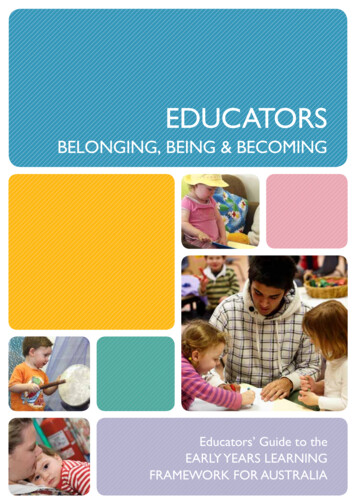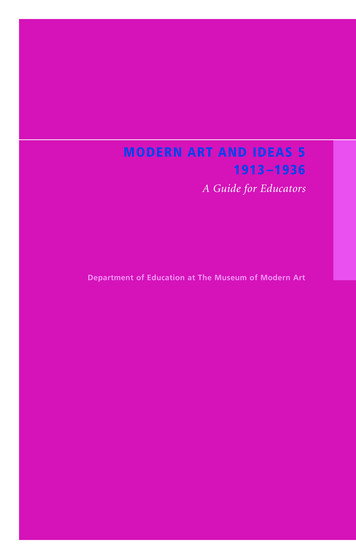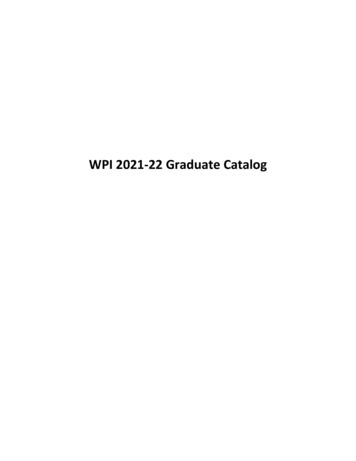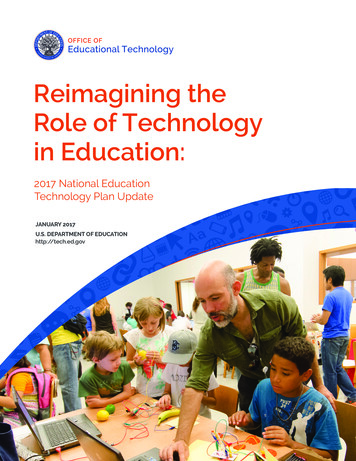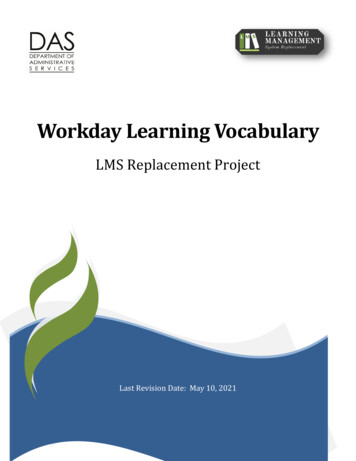
Transcription
CHILD ABUSE AND NEGLECTUSER MANUAL SERIESThe Role of E ducators inPreventing and Responding toChild Abuse a nd N eglectU.S. Department of Health and Human ServicesAdministration for Children and FamiliesAdministration on Children, Youth and FamiliesChildren’s BureauOffice on Child Abuse and Neglect
The Role of Educators inPreventing and Responding toChild Abuse and NeglectCynthia Crosson-Tower2003U.S. Department of Health and Human ServicesAdministration for Children and FamiliesAdministration on Children, Youth and FamiliesChildren’s BureauOffice on Child Abuse and Neglect
Table of ContentsPREFACE .1ACKNOWLEDGMENTS.31.PURPOSE AND OVERVIEW.7Guiding Principles.7Child Abuse and Neglect Statistics .8The Role of Educators.82.IDENTIFYING REASONS WHY EDUCATORSARE CONCERNED ABOUT CHILD ABUSE AND NEGLECT.9Community Efforts .10Educational Opportunities .10Legal Concerns .10Professional Responsibilities .11Personal Commitments .123.RECOGNIZING CHILD ABUSE AND NEGLECT .13Physical Abuse.14Neglect .16Emotional Maltreatment .18Sexual Abuse .19General Indicators of Abuse and Neglect.22Conversations with Families and Children .24Child Abuse within the School .274.REPORTING CHILD ABUSE AND NEGLECT .29Federal Legislation.29State Law.30Local Policies and Procedures Regarding Reporting.32The Role of Educators in Preventing and Responding to Child Abuse and Neglecti
Difficulties That May Be Encountered When Reporting.34Once the Report Is Made .365.PROVIDING SUPPORT AFTER THE REPORT:WHAT SCHOOLS CAN OFFER .39Sharing Relevant Information .39Support for the Child, the Parents, and the Family .39Child Abuse and Neglect Multidisciplinary Teams .43Community Coordination .446.PREVENTING CHILD ABUSE AND NEGLECT .45School-based Programs for Children and Adolescents .45School-based Programs for Families.50School-Community Programs .51Individual Action .52Conclusion .53ENDNOTES.55APPENDICES:APPENDIX A—GLOSSARY OF TERMS .59APPENDIX B—RESOURCE LISTINGS OF SELECTED NATIONALORGANIZATIONS CONCERNED WITH CHILD MALTREATMENT.65APPENDIX C—STATE TOLL-FREE TELEPHONENUMBERS FOR REPORTING CHILD ABUSE .71APPENDIX D—EDUCATORS’ CHECKLIST FORRECOGNIZING POSSIBLE CHILD MALTREATMENT .73APPENDIX E—SAMPLE LIST OF CONTACTS FOR REPORTINGSUSPECTED CASES OF CHILD ABUSE OR NEGLECT .77APPENDIX F—SAMPLE REPORT OFSUSPECTED CHILD ABUSE AND NEGLECT .79iiTable of Contents
PrefaceEach day, the safety and well-being of somechildren across the Nation are threatened bychild abuse and neglect. Intervening effectively inthe lives of these children and their families is notthe sole responsibility of any single agency orprofessional group, but rather is a sharedcommunity concern.The Child Abuse and Neglect User Manual Series hasprovided guidance on child protection to hundredsof thousands of multidisciplinary professionals andconcerned community members since the late1970s. The User Manual Series provides afoundation for understanding child maltreatmentand the roles and responsibilities of variouspractitioners in its prevention, identification,investigation, assessment, and treatment. Throughthe years, the manuals have served as valuableresources for building knowledge, promotingeffective practices, and enhancing communitycollaboration.Since the last update of the User Manual Series in theearly 1990s, a number of changes have occurred thatdramatically affect each community’s response to childmaltreatment. The changing landscape reflectsincreased recognition of the complexity of issues facingparents and their children, new legislation, practiceinnovations, and system reform efforts. Significantadvances in research have helped shape new directionsfor interventions, while ongoing evaluations help us toknow “what works.”The Office on Child Abuse and Neglect (OCAN)within the Children’s Bureau of the Administrationfor Children and Families (ACF), U.S. Departmentof Health and Human Services (DHHS), hasdeveloped this third edition of the User ManualSeries to reflect the increased knowledge base andthe evolving state of practice. The updated and newmanuals are comprehensive in scope while alsosuccinct in presentation. They are easy to followand address trends and concerns relevant to today’sprofessional.This manual, The Role of Educators in Preventingand Responding to Child Abuse and Neglect, buildsupon A Coordinated Response to Child Abuse andNeglect: The Foundation for Practice, the keystonepublication of the User Manual Series. It providesthe basis for the involvement of educators incombating the problem of child abuse and neglect.It also may be used by other professionals involvedin child abuse and neglect interventions, such aschild protective services, mental health, lawenforcement, health care, and early childhoodprofessionals, to gain a better understanding of therole of educators in child protection.The Role of Educators in Preventing and Responding to Child Abuse and Neglect1
User Manual SeriesThis manual—along with the entire Child Abuse and Neglect User Manual Series—is available from theNational Clearinghouse on Child Abuse and Neglect Information. Contact the Clearinghouse for a full listof available manuals and ordering information:National Clearinghouse on Child Abuse and Neglect Information330 C Street, SWWashington, DC 20447Phone: (800) FYI-3366 or (703) 385-7565Fax: (703) 385-3206E-mail: nccanch@caliber.comThe manuals also are available online at l.cfm.2Preface
AcknowledgmentsAUTHORCONTRIBUTING AUTHORSCynthia Crosson-Tower, Ph.D., taught in thebehavioral sciences department at Fitchburg StateCollege in Massachusetts for 24 years andcontinues to be the director of the Child ProtectionInstitute at the College. Currently, she consults forvarious schools and social agencies and maintains aprivate practice, Harvest Counseling andConsultation, which specializes in the treatment ofsurvivors of abuse and the perpetrators of sexualabuse as well as the supervision of otherprofessionals. She offers workshops and trainings,both nationally and internationally, for educatorsand other human service professionals.Carl R. Tacy, M.S.W., a consultant with CaliberAssociates, has more than 10 years experienceworking in clinical, policy, and managementpositions addressing substance abuse, domesticviolence, and child welfare issues. Additionally, hehas managed projects responsible for marketing,developing, and disseminating relevant products.Dr. Crosson-Tower is the author of numerouspublications, including: Understanding Child Abuseand Neglect, Exploring Child Welfare: A PracticePerspective, When Children Are Abused: AnEducator’s Guide to Intervention, Secret Scars: AGuide for Survivors of Child Sexual Abuse, HomelessStudents and How Schools Can Combat Child Abuseand Neglect. In addition, she has authored amonograph, Designing and Implementing a SchoolReporting Protocol: A How-to Manual forMassachusetts Teachers, for the Children’s TrustFund in Boston, and is currently working on achild sexual abuse text and a handbook for clergyto aid them in responding to abuse.Jeannie Newman, M.I.B.S., M.S.W., a consultantwith Caliber Associates, has held policy and directpractice positions in child welfare and familyprograms. She also has cultivated an extensivenetwork in various related professional fields,including domestic violence and fatherhood.ACKNOWLEDGMENT OF PRIOR EDITIONSThis manual, originally published in 1979 and1984 as The Educator’s Role in the Prevention andTreatment of Child Abuse and Neglect, by Diane D.Broadhurst, was revised and expanded by CynthiaCrosson-Tower in 1992.The Role of Educators in Preventing and Responding to Child Abuse and Neglect3
REVIEWERSBarbara AdolfiIndependent ConsultantKelly GiniesczkiClearview Elementary School, Herndon, VirginiaCorrine Anderson-KetchmarkSchool Social Work Association of AmericaSharon LongClearview Elementary School, Herndon, VirginiaKathy PintoHoward County, Maryland, Department of SocialServicesAnn RiceClearview Elementary School, Herndon, VirginiaSgt. Richard CageMontgomery County Police DepartmentWheaton, MDDiane DePanfilis, Ph.D.University of Maryland at Baltimore School ofSocial WorkBaltimore, MDPauline GrantFlorida Department of Children and FamiliesJacksonville, FLJodi HillConnecticut Department of Children and FamiliesHartford, CTRichard VerdugoNational Education AssociationRobert Ortega, Ph.D.University of Michigan School of Social WorkAnn Arbor, MISarah WebsterTexas Department of Protectiveand Regulatory Services (retired)Nancy RawlingsKentucky Cabinet for Families and ChildrenFrankfort, KYBrad WilcoxDepartment of SociologyUniversity of VirginiaBarry SalovitzChild Welfare Institute/National Resource Center onChild MaltreatmentGlenmont, NYTECHNICAL ADVISORY PANELThe following were members of the January 2001Technical Advisory Panel for the User Manual Seriescontract. The organizations identified reflect eachmember’s affiliation at that time.Carolyn AbdullahFRIENDS National Resource CenterWashington, DC4Lien BraggAmerican Public Human Services AssociationWashington, DCSarah WebsterTexas Department of Protective andRegulatory ServicesAustin, TXRon ZuskinUniversity of Maryland at Baltimore School ofSocial WorkBaltimore, MDAcknowledgments
The following members were subsequently added tothe Technical Advisory Panel:William R. (Reyn) Archer III, M.D.Hill and Knowlton, Inc.Washington, DCDavid Popenoe, Ph.D.National Marriage ProjectPrinceton, NJADDITIONAL ACKNOWLEDGMENTSThe third edition of the User Manual Series wasdeveloped under the guidance and direction of IreneBocella, Federal Task Order Officer, and CatherineNolan, Director, Office on Child Abuse and Neglect.Also providing input and review was Susan Orr,Associate Commissioner, Children’s Bureau.Bob ScholleIndependent ConsultantPittsburgh, PABrad Wilcox, Ph.D.University of Virginia, Department of SociologyCharlottesville, VAThis manual was developed and produced by Caliber Associates, Fairfax, VA, under Contract NumberHHS-282-98-0025.The Role of Educators in Preventing and Responding to Child Abuse and Neglect5
CHAPTER 1Purpose and OverviewThis chapter provides a very brief overview ofchild abuse and neglect and the role ofeducators in preventing and responding tomaltreated children. The reader is referred to thefirst manual in this series, A Coordinated Response toChild Abuse and Neglect: The Foundation forPractice, for an indepth description of the varioustypes of child abuse and neglect.GUIDING PRINCIPLESParents have a fundamental right to raise theirchildren as they see fit, and society presumes thatparents will act in their children’s best interest.When parents do not protect their children fromharm or meet their basic needs—as with cases ofchild abuse and neglect—society has aresponsibility to intervene to protect the health andwelfare of these children. Any intervention intofamily life on behalf of children must be guided byFederal and State laws, sound professionalstandards for practice, and strong philosophicalunderpinnings.The key principles guiding child protection arelargely based on Federal statutes, primarilydelineated in the Child Abuse Prevention andTreatment Act (CAPTA) and the Adoption andSafe Families Act (ASFA). CAPTA, in its originalinception, was signed into law in 1974 (P.L. 93247) and is reauthorized by Congress every 5 years.CAPTA was reauthorized on June 25, 2003, as partof the Keeping Children and Families Safe Act of2003 (P.L. 108-36). ASFA was signed into law in1997 (P.L. 105-89) and built upon earlier laws andreforms to promote the safety and well-being ofmaltreated children. These laws and other guidinglegislation are referenced throughout thispublication and are specifically discussed in“Federal Legislation and Programs” in Chapter 8 ofA Coordinated Response to Child Abuse and Neglect:The Foundation for Practice. ASFA promotes threenational goals for child protection: Safety. All children have the right to live in anenvironment free from abuse and neglect. Thesafety of children is the paramount concern thatmust guide child protection efforts. Permanency. Children need a family and apermanent place to call home. A sense ofcontinuity and connectedness is central to achild’s healthy development. Child and family well-being. Children deservenurturing families and environments in whichtheir physical, emotional, educational, andsocial needs are met. Child protection practicesmust take into account each child’s needs andshould promote the healthy development offamily relationships.In addition, ASFA underscores the importance ofthe accountability of service delivery systems inachieving positive outcomes for children related toeach of these goals.The Role of Educators in Preventing and Responding to Child Abuse and Neglect7
CHILD ABUSE AND NEGLECT STATISTICSTo help illustrate the importance of preventing andresponding to child abuse and neglect, it may beuseful to examine the scope of its occurrence. Thefollowing findings describe reported childvictimization rates by major types of maltreatment asstated in the National Child Abuse and Neglect DataSystem (NCANDS) for 2001: Neglect. More than one-half of all reportedvictims (59.2 percent) suffered neglect(including medical neglect), an estimated rate of7 per 1,000 children.Physical abuse. Approximately one-fifth of allknown victims (18.6 percent) were physicallyabused, an estimated rate of 2 per 1,000children.Sexual abuse.Of all reported childmaltreatment cases, almost one-tenth (9.6percent) had been sexually abused, an estimatedrate of 1 per 1,000 children.Psychological maltreatment. Less than onetenth (6.8 percent) were identified as victims ofpsychological maltreatment, or less than 1 per1,000 children.1(Note: Some children are reported as victims of morethan one type of maltreatment.)THE ROLE OF EDUCATORSworkers, school nurses, special educationprofessionals, administrators, and other schoolpersonnel have in helping maltreated children.The Role of Educators in Preventing and Responding toChild Abuse and Neglect is intended to expand theinformation provided in A Coordinated Response toChild Abuse and Neglect: The Foundation for Practiceby addressing issues unique to educationprofessionals. Specifically, this manual will addressthe following topics: Identifying reasons why educators are concerned; Recognizing child abuse and neglect; Reporting child abuse and neglect; Providing support after the report—whatschools can offer; Preventing child abuse and neglect.Appendices providing sample instruments and otherinformation also are included.Using this manual, the educator can contribute to theincreased well-being of children in a variety of ways.Certainly, the first area of defense against the problemof child maltreatment is one of awareness. Eachindividual who is involved with children has theobligation of knowing the basics of how to protectchildren from harm. The protection of children is notonly an individual issue, but a community concern aswell. Educators are an integral part of the communityand, as such, can lead and be involved in communityefforts to combat child maltreatment.Children and adolescents spend a large portion oftheir time in school, which gives educators moreaccess to students than most other professionals. Forthe purpose of this manual, the term “educator” ismeant to encompass not only the classroom teacher,but also other school personnel involved in servingthe child. This manual is designed to examine theroles that teachers, school counselors, school social8Purpose and Overview
CHAPTER 2Identifying ReasonsWhy Educators AreConcerned About ChildAbuse and NeglectThe educator has a vital role in identifying,reporting, and preventing child abuse andneglect. Over the last few decades, variousorganizations have developed programs directed atinforming educators that they are a valuableresource. Professionals submitted more than onehalf (56.5 percent) of the cases referred to andassessed or investigated by child protective services(CPS), with education personnel the most frequentsource of reports (16.2 percent).2 This highlightsthe important role of educators and indicates thatmany educators are already involved in respondingto this issue, yet more can be done to addressmaltreatment. Several studies indicate that manyeducators are not entirely clear what the indicatorsof child abuse and neglect are or how to reportsuspected maltreatment.3 One study surveyed2,793 schools to assess staff readiness to reportmaltreatment. Because only 51 percent of thosecompleting the questionnaire had received trainingon reporting child maltreatment, there is still muchwork to be done to alert educators to theirimportant role in identifying and reporting abuseand neglect.4There are many reasons why educators are so vitalin identifying, treating, and preventing childmaltreatment. First, they have close and consistentcontact with children. Second, educators have aprofessional and legally mandated responsibility forreporting suspected maltreatment.Whileeducators facilitate children’s learning, childrencannot learn effectively if their attention or energyis sapped by the conflicts inherent in beingmaltreated. Third, school personnel have a uniqueopportunity to advocate for children, as well asprovide programs and services that can helpchildren and strengthen families. It is important torealize that a positive relationship with asupporting adult may enhance the resiliency ofchildren who have been abused, are at-risk forbeing abused, or live in a home where nomaltreatment occurs but the family experiencesother problems, such as substance abuse.This chapter discusses a variety of reasons whyeducators must become involved in preventing andresponding to child abuse and neglect. Thesereasons are related to: Community efforts Educational opportunities Legal concerns Professional responsibilities Personal commitmentsThe Role of Educators in Preventing and Responding to Child Abuse and Neglect9
COMMUNITY EFFORTSDealing with child abuse and neglect is, in fact, acommunity effort. As leaders in their communities,educators are often in an ideal position to initiate thistype of teamwork. A variety of formal programsinvolving the schools and the community have beenespecially effective in addressing the difficult and selfdestructive behavior in youth that often is anaftereffect of child abuse.Model programs use community resources topromote the concepts of cooperation, peer mediation,independence, and acceptance of the common good.5A good example of one such community effort tookplace in a small city and resulted in the conviction forsexual abuse of a popular clergyman who had beeninvolved with a local Boy Scout troop. Once theinitial shock had subsided, the church membersjoined with local school officials and other citizens toaddress the concerns of the community’s children andtheir parents. Support groups for both the abusedboys and the nonabused boys who knew theperpetrator, as well as awareness and educationalprograms, helped the stunned community recover.EDUCATIONAL OPPORTUNITIESThe primary goal of the education system is to teach.In order to achieve this, it is sometimes necessary toremove barriers that impede a child’s ability to learn.Every year, millions of dollars are authorized throughvarious legislative acts for this purpose, including theNo Child Left Behind Act of 2001 (P.L. 107-110),the recent reauthorization of the Elementary andSecondary Education Act of 1965, and the Educationfor All Handicapped Children Act (P.L. 94-142),which is now called the Individuals with DisabilitiesEducation Act or IDEA (P.L. 101-476). These lawsprotect the right of every child to an education andattest to the Nation’s commitment to remove barriersto each child’s ability to learn. The trauma andresidual effects of child abuse and neglect are barriers10to learning as much as any type of academic orphysical impediment that schools spend so much timeaddressing.6Educators are trained to recognize and intervenewhen children are not able to benefit fully from theireducational opportunities. This training makes themuniquely qualified to detect indicators that maysignify that a child is being maltreated. Since schoolsare one of the few places in which children are seenalmost daily, educators have a chance to see changes inappearance and behavior. From classroom teachers toguidance counselors, as well as social workers, nurses,psychologists, and administrators—everyone becomesan integral part of the educational team to helpchildren.To learn more about legislation related to educationissues, visit http://www.ed.gov/index.jsp.LEGAL CONCERNSEvery State legally mandates that educators reportsuspected child abuse and neglect. A mandatedreporter is anyone required by State law to reportmaltreatment to the designated State agency.However, some States clearly define that teachers,principals, nurses, and counselors are included in thismandate, while other States designate all schoolpersonnel. In addition, almost every State levies apenalty against mandated reporters who choose not toreport. This penalty ranges from a fine, amisdemeanor charge, or time spent in jail. Untilrecently, most States did not strictly enforce thesepenalties, but this has changed within the last fewyears.A number of States have sanctionednonreporters for failing to obey reporting laws, so it isimportant that educators know the reporting laws fortheir State.In addition to penalties for not reporting abuse andneglect, all States provide immunity from civilliability and criminal penalty for mandated reporterswho report in good faith. In other words, the lawIdentifying Reasons Why Educators Are Concerned About Child Abuse and Neglect
requires educators to report child abuse and neglect,provides protection for those educators who becomeinvolved, and penalizes those who fail to meet theirobligations.PROFESSIONAL RESPONSIBILITIESEducators have a keen sense of their professionalresponsibility to the children in their care. They areconcerned about the health, safety, and happiness ofthese children. Educators are aware that they are rolemodels for the children they teach and that they maybe an important source of support, concern, and carefor many children. Educators want to do what is bestfor the children in their care because their professionalstandards require it. As mandated reporters, alleducators have the responsibility not only to reportsuspected abuse, but also to know how to make areport, to be familiar with their district’s policies andreporting procedures, and to communicate with CPS.Additionally, as adults in constant contact withchildren, educators must be aware of issuessurrounding physical contact with a child—what isconsidered appropriate versus inappropriate ineveryday classroom activities—as well as the issue ofcorporal punishment.Many daycare centers and schools are requesting oreven mandating that their staff not touch childrenbecause of fears that allegations of child abuse will bemade against the educators. Nurturing touch,however, may enhance learning for some children. Allchildren, and certainly those who are not nurtured athome, may be robbed of this important element.Educators should not be afraid of “normal” touching,as it is another positive gesture or affirmation that theycan give. It is important to realize, however, that whatis considered “normal” varies between individuals andis affected by such factors as personal experience andcultural background. Touching is always a concern ifit is done in secrecy or isolation from others or for thesexual gratification of the educator. Children need tobe informed and empowered about what isappropriate and inappropriate touching.7 Preventionprograms are now designed to inform children aboutgood, bad, and confusing touch. “Good touch”usually refers to hugs, encouraging pats, and otherpositive gestures. It is important to remember thatpeople may interpret these gestures differently. Forexample, some people prefer not to be hugged; forthem this is not “good touching.” “Bad touch”usually refers to hitting, punching, biting, and otheracts that hurt. “Confusing touch” refers to contactthat may not feel quite right to children. For instance,the child may feel that the touch lasts too long or isdifferent in some way from the way in which otherchildren are touched.Once children are informed about “good,” “bad,” or“confusing” touch, respect for children requires thatthey be given permission to express their feelingsabout receiving such touches. Children who aretrained to recognize how certain touches feel to themand who are encouraged to express their feelingsshould be allowed to tell the teacher when somethingdoes not feel good. Certainly, no child should bemade to feel solely responsible for his or her ownprotection. This training, however, may help childrento feel more confident and comfortable talking withadults about potentially inappropriate touch.One type of touch used in some schools is corporalpunishment. Currently, over half of the States have legallyprohibited the practices of hitting, paddling, or punishingchildren with physical force. Practice varies across schoolsystems and jurisdictions. Additionally, research andopinion vary regarding both the effectiveness and impactof corporal punishment. Most studies imply thatcorporal punishment, on its own, does not teach rightfrom wrong or deter future misbehavior. 8There are several considerations regarding physicalpunishment in schools. When children are “paddled,”school personnel may not always consider alternative orother, more creative forms of punishment. The followingcase example illustrates the potential benefits of seekinginventive, alternative forms of discipline.The Role of Educators in Preventing and Responding to Child Abuse and Neglect11
Educators also should be aware that any method ofdiscipline, whether it is time-outs, corporalpunishment, or exclusion from activities, can have anunintended impact on an abused or neglected child.Some children who have been abused may actuallyinvite such discipline, if it is the only attention theybelieve they can get or to which they are entitled. Thepunishment may be ineffective as a way to stopmisbehavior in such
The Role of Educators in Preventing and Responding to Child Abuse and Neglect U.S. Department of Health and Human Services Administration for Children and Families


